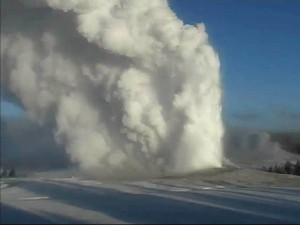
By Janet White
The geysers and other thermal features of Yellowstone National Park make up a vast, complex and dynamic collection of constantly changing natural wonders. A wide range of amateur hobbyists and professional geologists and hydrologists regularly track the activities and changes in Yellowstone’s thermal features and post their findings at various sites online. Here’s a look at thermal activity in December 2012 and January 2013.
Since the Park opened for the winter season on December 15, there’s been a gain of almost an hour more of daylight. As of early February, the days will be longer than 10 hours.
Why be so concerned with the hours of daylight? Because it greatly affects what observations can come in to geyser observation websites like Geyser Times. Winter webcam geyser observation is difficult at best with the additional steam and foggy weather obscuring the view of Geyser Hill and farther down the Upper Geyser Basin. But the people who gather regularly in the Old Faithful Webcam Chat Room (not affiliated with the National Park Service, Yellowstone Gate or any group, for that matter) are pretty good at sorting out what steam cloud might be which geyser erupting. All of us are grateful to the gift of this window on the Upper Geyser Basin courtesy of the Yellowstone Park Foundation and Canon.
Thanks to a few geyser-wise visitors to the park and tour guides who share their observations, we do get a glimpse of some of what is happening.
Beehive Geyser gave a few eruptions that weren’t preceded by Indicator Geyser. They came on Dec. 17, Jan. 17 and Jan. 23. It seems to be having these “unannounced eruptions” about twice a month. Beehive has also given some “Herb Warren” splashes—large splashes that get your attention not terribly long before the next eruption. While geysers are not named after people, the common usage of the name for such splashes persists. Herb Warren was a geyser gazer from days past who loved to watch Beehive’s slender eruptions, as many of us do.
Plume Geyser is still highly erratic and showing very little desire to fall back into its familiar near-hourly mode of giving 4 or 5 bursts in an eruption. Instead, it’s rarely seen, but when it does show up, it does it in style, giving a dozen or so bursts. In a way, this behavior is much more interesting, but the regularity is simultaneously missed. Plume was only seen on three days so far this winter: Dec 29 (three times: 11 bursts, 11 bursts and then a third eruption with 9 or 10 bursts). It likely erupted overnight sometime on Jan. 24-25 as the snow around the crater was gone. And on Jan. 26, a few lucky folks were treated to a 12-burst eruption. Gurgling in the crater is said to increase just before an eruption.
The small geyser not far from Beehive, near the boardwalk below Marmot Cave Geyser, informally known as “The Mouth,” has widened its vent yet again. On Dec. 29, visitors to Geyser Hill were seen on the webcam stopping to look in that general direction when extra steam was noticed there as well. It’s possible this was just a coincidence, but some eruption was strong enough to widen the opening.
The Sawmill Group has seen both ‘modes’ this winter season so far with Penta and Churn Geysers seen in eruption at times as well as Sawmill taking control and erupting for longer times. There are years when Penta is rarely seen, so many hope the Sawmill Group continues to ‘take turns.’
Fan and Mortar are described in geyser logs as having “no evidence of eruptions” occurring. That typically means they are still covered with snow that would disappear if they had been active. It’s not unusual for them to take naps for months or even years at a time.
Morning Geyser is still active to the delight of many. Yellowstone Tour Guides, based out of Big Sky, Mont., have given detailed updates on sightings of eruption evidence.
Geyser gazer Will Boekel has created a video of a compilation of some noteworthy thermal activity. The first large geyser in Boekel’s video is Giant Geyser, and you can hear people are screaming as it erupts (some folks are completely enthralled with geysers). Giant Geyser was last witnessed erupting Jan. 22, 2010, so we have passed the three-year mark without activity from this amazing geyser.
If you’re already planning your trip to Yellowstone this summer, consider working in extra time to get to know the geysers better. There’s so much to see Beyond Old Faithful
